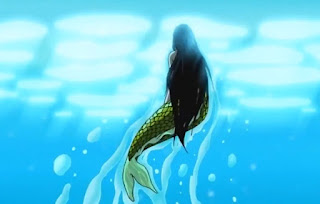 |
| magindara |
Long ago in a province city in Bicol called Anilao live a girl named Maria, she was baptized in the ways of the Colonials from the Wests but she and her family secretly still worshiped and believed in the old ways. One night a terrible storm passed their province. The next day she and her brother went to play by the river, In the river, they saw a beautiful maiden, she looked injured. As the two came near the lovely maiden they were shocked. She had long flowing hair which covered the top part of her body but the lower part of her body was like that of an eel. The children also noticed that she was trapped, her tail caught between driftwood in the river. Scared the two children ran home and told their mother, Pedro the elder of the two children told their mother that they must tell the parish priest about it, Their mother scolded him and said that they would be punished by the priest if ever they told him that. Their mother told them that they must help the maiden, the mother told them that it was a Magindara that might have been washed their during the storm, but only the children can help it because they are known to be vicious towards an adult. The next day Maria and Pedro went back to the river, scared but reminded that their mother told that the creature would never harm children they came close and helped her. The mermaid told the children she was not a Maginadara but rather a Naga. That Magindara are different from her kind but she is of higher status. The two children freed her tail. The beautiful Naga thanked the children and some how magically made it drizzle. The children danced happily under the summer rain. Before the Naga left she told the children that they would repay them for their kindness and if ever they would need help in the seas, all they need to do is either chop a lock of their hair of pluck some strands. The hair will signify they are calling her and she will help. Then she swam away and also the drizzle stopped.
Years have passed and Maria and her brother Pedro had not forgotten the beautiful Naga. One day as Maria was walking by the beach he herd screams suddenly a band of Moro men grabbed her. Things happened so fast and she realized she was being abducted by these strong men. Men who looked thicker in muscle then the men from her community. They were forced in their boats, Maria and the other women started sobbing. Wiping her eyes she looked at the waters and remembered the lovely Naga, she pulled strands of hair from her nape and prayed that the Naga would help her. A thud on the side of the Moro boat. Then another, Maria got a glimpse of colored scales.
 |
| magindara |
The boat flipped, and she and the Moro men and the abducted women were now the in the waters. Maria saw beautiful women with long flowing hair with lower bodies of multi-colored scaled fishes. They were beautiful but they tore the flesh from the Moro men. She would have drowned in fear but something was pulling her. Like the other women the lower half of her body was like fish but unlike those of the magindara that were colorful and scaled, hers was of gray and silver. It was the lovely Naga she and her brothers helped before. The seven girl, Maria one of them woke up on the shores. The whole Anilao was in joy that the boat of the Moros had sunk and not one of them saw seen, and all the girls that were abducted were safe. It drizzled that day and only Maria knew that it was a sign from the lovely Naga who had rescued them.
REMINDER
The orally transmitted mythology of the Philippines is intended for sharing and understanding, not for appropriation, commercial exploitation, or the promotion of foreigners and foreign products. It is a dynamic narrative tradition that evolves over time, distinct from the standardized mythologies found in Western and European cultures. Unlike these established mythologies, the Philippine government has not mandated standardized versions of stories and legends.
Orally transmitted stories undergo variations and evolve over time, resulting in numerous different versions. There are many different version told by Filipinos,and retold by Filipinos.






























